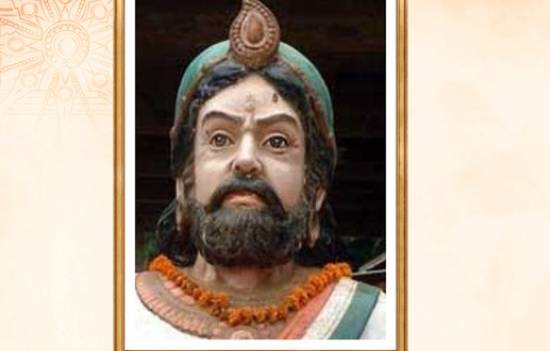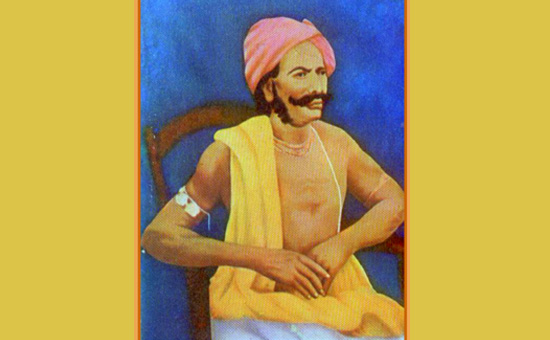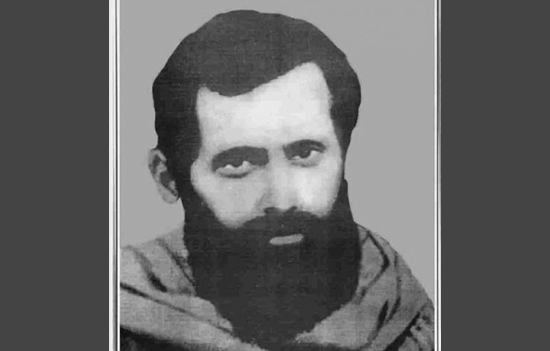- Article covers the resistance to British rule in 1804 and the big revolt under Buxi Jagabandhu in 1817. It includes the Martial tradition of Paika and the causes of discontent against British rule.
eSamskriti thanks Prof Rao for agreeing to share his work. Since the extract from Prof Rao’s thesis is long we present a precis. We also thank Smita B’s April 5 2022 tweet
because it is her tweet on Buxi J that stirred the spirit of inquiry in us. Thanks
to Rabi S for connecting us with Prof Rao. Errors are all mine. Pranams to Dr
Narayan Rao - Editor.
There
were uprisings against British colonial rule. The strong link between the
popular insurrections during the pre-nationalist era in your long struggle
should be established in a true perspective. The respectability and autonomy of
such rebellions, however brief and abortive, is to be highlighted. We came
across a series of such protests against British Rule during the 18-19th centuries, manifesting people’s resistance against British exploitation. Colonial rule has unsettled the traditional way of life and Government because of which the British faced serious challenge to their authority.
However,
such rebellions were referred by colonial historians as local and the
leadership posed no real challenge to British power. Similarly, the popular
movements among tribals known as melis,
hools and ulgulan were mainly against the colonial forests laws and
encroachment of their tradition rites.
Historical Background
In
1568, after the defeat in Gharikita war the military strength of the once
powerful Odisha lost its political supremacy and independence. Before the
Afghans consolidated their hold the Mughals, under Man Singh, annexed Odisha to
the Mughal Empire. The territories south to the Chilika Lake became the tract
called Northern Sircar and was ruled by the Nizam of Hyderbad. This fell into
the hands of the British in 1765.
In
order to establish a link between Madras Presidency and Bengal, the British had
to conquer Odisha from the Marathas. They wanted to ensure neutrality of the
Raja of Khurda with the promise of Rs 1 lakh and restoration of 4 praganas.
Jayee
Krushna Rajguru, who was the chief Priest and regent of minor king Mukunda Deva
II did not back the proposal but eventually respected the desire of the king.
He believed that British have no permanent friends or enemy. In the war against
Marathas, Britishers in 1803 got the province of Cuttack including the port of
Balasore from the Raja of Nagpur in perpetuity.
Odisha
came to British bit by bit. This had a negative effect on the homogeneity of
the Odiya people and jeopardised their integral development.
 Jayee Rajguru. Pranams.
Jayee Rajguru. Pranams.
First Resistance in 1804 and Jayee Rajguru
In
the meantime, Bhoi dynasty was established in Khuda by Rama Chandra Deva I, who
had constructed an impregnable fort at the foot of the Barunei hill. The king
with the title Gajapati (Thakur Raja) had huge spiritual impact on the Rajas of
feudatory states and the people of Odisha as a whole.
After
the British defeated the Marathas in 1803, they did not honour their promise to
the Raja of Khurda of returning the four Praganas as referred to above. Rajguru
was upset and went to the court of Harcourt where his plea was dismissed. The
British the Praganas belonged to the Marathas, who were now defeated. So these
four praganas were legally under the possession of the British Govt. However,
the British agreed to pay Rs 1 lakh as promised.
The
Rajguru returned with a desire to drive out the Britishers. He reorganised the
Paikas with modern technique of war, concluded a tripartite agreement with 2
other kings and declared war against the British in 1804, under the banner of
the king. They lost the war. Rajguru was executed in a brutal way. The king was
banished and Khurda under direct administration of Major Fletcher.
Thus,
the armed resistance in 1804 against the British policy of deceit and treachery
is regarded as a precursor to the great revolt of Paika in 1817 under the
leadership of Buxi Jagabandhu.
 Veer Surendra Sai - freedom fighter of Odisha.
Veer Surendra Sai - freedom fighter of Odisha.
Martial Tradition of Paik
The
history of Odisha is the history of military and chivalrous people known for
being sturdy, stubborn and adventurous. There is enough evidence to give an
authentic account of the military tradition of the people of Odisha.
PAIKS
constituted the main back of the army and enjoyed hereditary rent free land.
They functioned as farmer and soldier in uniform. Besides defence, they were
watchman of strategic forts, royal palace, arms depots, royal treasury etc. The
paiks are described in a graphic manner by Kanhai Champatiroy in Paika Kheda. The book gives a detailed account of paik martial art including heritage, weapons, war drums and different strategy of operation. Mayadhar Mansingh in History of Oriya Literature wrote that “Paika Kheda should be taken as a military document in the entire field of Indian literature.” There was no caste bar on who could join. In each village there were Akhadas for training and practice of martial art.
There
were different categories of Paiks like Gherua Paik, Checa Paik etc. Veda Paiks
were part of the espionage system. Cheka Paiks were trained in guerrilla
warfare. Pota Paiks were good at managing boats in the rivers and sea. Pota
Paiks were like coastal guards. Paiks used weapons like Jambura, Banka, Katari
and Saleli Peta Chita Landhuka flint guns, daggers, swords, shields etc. Swords
were of different types. Bows were of 13 types. Military strategy (Vyuhas) had
formulations like Chakra, Suchi etc.
The
march to battle started with worshipping the ancestral deities (Ista
Deva/Devis) accompanied by a chorus of music bands. Read military history of
Odisha by Ramesh P Mohapatra etc. Hence, the Paik tradition goes back to the epic
age and Kalinga war (261 BC). False views are being spread about Paiks. The
truth is that Buxi Jagabandhu inherited a huge martial tradition, when he came
forward to give leadership to the accumulated anger of all the segments of
society against British maladministration and exploitation.
Causes of Popular Unrest
The
British wanted to end the sovereignty of the Gajapati of Khurda and their
influence over the feudatory states of Odisha. Though the king lost political
power he continued to be the hereditary superintendent of the Jagannath Temple.
The first victims of British rule were the Paiks who were deprived on their
rent free land and asked to pay tax to the Government.
The
short term revenue settlements affected the royats (peasants) due to repeated
assessment. Many royats could not pay the tax in time and became impoverished.
The British did not study the existing system and forcibly introduced new laws
disrupting their traditional life pattern. This resulted in mass
discontentment.
The
zamindars too became a victim of heavy and ever increasing assessment. Their
lands were auctioned, due to non-payment of taxes and bought by Bengalis and
British officials. Non-Odiyas were appointed as Tehsildars and Darogas who
utilised their position and amassed huge wealth illegally.
From
time immemorial CAURIE (Shell) was the medium of exchange in Odisha. In 1804
the British demonetised Caurie and introduced silver (Shika) coins which were
manufacturer in Bengal and Arcot of Madras. Revenue was collected in silver
coins. Government fixed the exchange rate as 4 Kahanas and 2 Panas for 1 silver
coin. Due to fluctuation of supply and demand, the market rate was about 7
Kahanas to the rupee. The royats (cultivators) suffered a loss from the
exchange of cowries for silver. This move was anti-people.
During
Maratha rule there was no restriction on the manufacture and sale of salt.
British
introduced salt Regulation in 1804. Subsequently, the introduction of salt
monopoly resulted in shooting of the price from 3-4 annas a maund to Rs 2 or more. The poor found it
difficult. Thus, the salt policy added to the discontent of the people. This
ignited the people at large to free themselves from the shackles of colonial
rule.
 Gopandhu Das-freedom fighter, social reformer & poet of Odisha
Gopandhu Das-freedom fighter, social reformer & poet of Odisha BUXI JAGABANDHU
He was born at Rorang Garh around 1769. He
was commander-in-chief of the armed forces of the Raja of Khurda. The post was
held by his ancestors on hereditary basis. Because of his exalted position,
wealth and formidable command he was respected by the people of Odisha, as next
to the Raja. He had strong common sense and was a practical statesman. His full
name of Jagabandhu Bidyadhar Bhramarabar Rau.
Soon after British conquest of Odisha and
suppression of 1804 uprising, he lost his jagir lands, reduced to a common tax
payer. Soon he had to forfeit Killa Rorung. This angered him. The temporary
settlement, rigorous of collection of revenue, oppression of the unscrupulous Amalas
and Darogas, entry of absentee landlords, excessive rise in the price of rice
and salt and demonetiation of caurie created a chaotic state. The resistance
came from all classes of people because traditional order and life were
disturbed by the British. Buxi was determined to provide leadership with the
support of disgruntled tribals of Ghumsar and Banapar esp. Panas and Kandhas.
His courage, determination, courage and
personality kept the British in a state of anxiety for 7 years. He raised a revolt
under the banner of Gajapati (former Raja of Khurda) in order to gather people
support and of the Ganjam chiefs.
Spread of the Revolt
The revolt heralded in the last week of March
1817. The Khonss from Ghumsur marched too. They were displeased with British
rule of the Forest Laws and encroachment on their traditional beliefs and
rituals. They joined hands with Buxi as he was related to the royal family of
Ghumsar, Badamba and Shergada. They were also joined with Souras, who were
employed as agents carry out plan of revenge.
At Banpur they attacked police station and other government buildings and ransacked them. At Khurda, they sacked the Tehsildar’s office. The insurgents attacked the government Treasury and confiscated money that would be used to implement their plans. A section of the army entered Lemlai and killed one C Pattanail who was considered as the informer of the government. They entered Panchagarh. The Rani ran away but the Dewan was killed. Buxi apprehending government forces from Cuttack stationed a contingent of veteran paiks at Gangapada.
The British failed to suppress the rebellion
at Khurda. British officials fled. Local chiefs were encouraged to join the
fight against British rule. The government imposed martial law in Khurda.
The main contingent of rebels marched towards Pipil. The main body of paiks including the Khonds of Ghumsar entered Puriunder. Buxi etc were engaged in retaliating against British officials. Officials stationed at Puri fled. Rebels were priests and sevayats of Jagannath temple. King Mukund Deva II was approached to proceed back to Khurda and reclaim his kingdom. However, the king remembered his torture during the 1804 uprising refused. Instead he sent a message seeking military aid for his security. Buxi was not discouraged, he appealed to the rajas of Garjat states in the name of Thakur Raja for support.
The revolt spread and more took part in the
uprising. It also spread to Baripada, Balasore, many parts of western Odisha
including Sambalpur and Nagpur in central province also joined the movement.
The tremor was also felt in the Odia tracts of Bengal and Andhra. Thus, the
movement spread to a larger geographical area.
The
rebellion was reported to have been crushed by the use of machine guns and gun
powder. By April1818, the Britishers were in control of Khurda. But Buxi Jagabandhu could not be captured along
with numerous companions.
Buxi and Guerrilla Warfare
The
flight of Buxi to the forests and the witch hunt carried out by the British is
a romantic chapter in the Pain revolt of 1817. The British believed that tranquillity
in Khurda is incomplete without the capture of Buxi.
Guerrilla
Warfare lasted for seven long years against adversity, shows the patriotic
fervour. On 19/4/1819 Buxi wrote a letter to Lt Melville for restoration of
minor king Ramachandra Deva to his gadi, which will solve all problems.
Ultimately
Buxi was persuaded to surrender with the mediation of Bewartabarju Paikaray. He
arrived in a procession on elephant back and signed an agreement on May 20,
1825. It was stated that Buxi would not leave Cuttack without the permission of
the commissioner. He had to forfeit the title of buxi. He was allowed to stay
with his family at Cuttack with a monthly pension of Rs 150/ per month life-long.
The agreement was devoid of any impolite condition. Thus, the surrender was
commensurate with his dignity.
In
fact, the British accepted most of his demands. Buxi emerged as a hero without
any indignity associated with the surrender. He breathed his last at Cutack on
January 24, 1829. Thus, he lived for about sixty years.
Evaluating Buxi
Reviewing
the course of events it is observed that Buxi possessed strength of mind, iron
will, dogged resistance and determination to uphold the cause with unflinching
devotion. For eight years he kept the British Government in perpetual anxiety.
He was a patriot and celebrated leader in the saga of Odisha’s freedom movement. The Revolt of 1817 was due to grievances and discontentment of the people against exploitative colonial rule. The Paik revolt of 1817 deserves its rightful place as the first war of independence.
To read Bibliography click on PDF
Author Prof (Dr) Narayan Rao M A, M.Phil, PhD and Former Registrar Berhampur University, Odisha. The title of his thesis is, “Search for Identity of Odisha and Creation of a Separate Province.” Currently, he is National Fellow of Indian Council of Historical Research (ICHR), New Delhi. He has published 56 Research Papers and authored four Books.
Also read
1. Veer Surendra Sai – freedom fighter of Odissa
2. Gopabandhu
Das was a freedom-fighter and poet of Odisha
3. Alluri
Sitaram Raju, freedom fighter of Andhra
4. Vasudev Phadke – a torch bearer of the freedom movement
5. Tridev
of freedom fighters of Tamil Nadu
6. Freedom
struggle in Punjab
7. Lal, Pal and Bal the Tridev of India’s freedom movement
8. Album of Sun
Temple Konarak
9. Album
of Sudarshan Arts and Crafts Village
10. Handloom
Saris of Odisha
11. 70
page book in PDF by Prof Mohanty on the Paika Rebellion